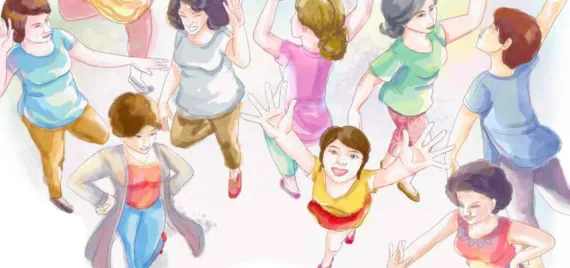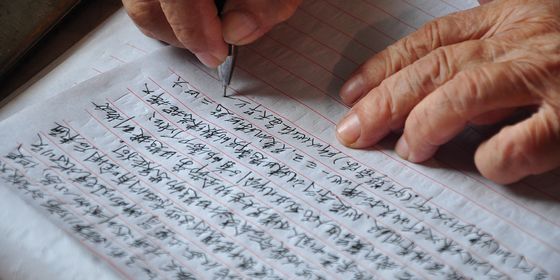China’s famous dama phenomenon
It started with a gold rush. A drastic drop in price in April 2013 saw thousands upon thousands of middle to late aged Chinese women rapidly buying up vast amounts of the precious metal—about 100 billion RMB worth in just 10 days, or some 10 percent of the world’s annual production. The investment was so fast and large that investment banks such as Goldman Sachs, who had previously been taking short positions on gold, had to reverse their stance, and the gold price soon stabilized. These Chinese women were not to be messed with; they had moved an entire market. The Wall Street Journal called them dama (big mothers) and the world started to take notice. Before long, rumors were speculating that this particular set of Chinese women were even set to enter the dictionary, the Oxford English Dictionary at that.
The term dama has been around for a long time, but lately the semantics seem to have somehow changed, and the word has taken on a whole new set of connotations, often veering toward the pejorative.
The dama have been closely watched, scandalized, and written about ever since, their influence going beyond the gold market, and if journalists are to be believed (and they often aren’t), they have become a cultural phenomenon in their own right, their thrifty eye buying up everything from South Korean holiday homes to bargain-basement, dilapidated properties in Detroit; apparently they are even investing heavily in the online crypto-currency, Bitcoin.
It’s not just their investments that are being monitored closely, but their whole way of life. Though feared, the dama have somewhat become a figure of fun, with their favorite pastime, dancing in public squares, particularly suffering the nation’s ire. It’s not the dancing per se that is causing problems, but more the way they go about it. They reportedly convene in public spaces and blast out loud, irritating music at all hours, with a particular focus on early morning and in the evening. And, they don’t just dance in China; sightings of the elusive dama have been noted as far away as outside the Louvre in Paris.
Non-dama neighbors have not taken to kindly to the square dance invasion and have fought back in a number of ways, with Chinese media reporting on the various methods people have used to make the dancing stop, including attack dogs, shooting guns in the air, purchasing military-grade loudspeakers to drown out the noise, and even the throwing of feces. But the dama are tough cookies and seem largely unmoved. In fact, they are so sufficiently tough that the Chinese government has even seen fit to have them working as neighborly counterterrorist informants, with many of them being recruited in their local communities to find information on those committing nefarious crimes. Some have, perhaps jokingly, suggested that dama’s proclivity for nosiness leave them incredibly well suited to the job.
Other less than personable traits of the so-called dama include interfering in the marriages of friends and family, giving unwanted and unsolicited advice to anyone and everyone about absolutely anything, henpecking their husbands, dominating public spaces, queue jumping, relentless boasting about their offspring’s achievements, and generally poking their nose in other people’s business. But, for some reason, somehow, it’s always their incessant dancing that looms large in the public imagination.
On a beautifully warm midsummer’s night in Beijing’s Chaoyang District, a colleague and I decided to go and speak with some of these infamous dama, very much hoping that they were not quite as hectoring and unforgiving as the public perception makes out.
We found a small group of less than 20 dancing dama, accompanied by a small gaggle of their men folk noisily beating drums, energetically dancing opposite a Starbucks and outside a KFC on a very busy roadside. It seems an odd place to carry-out a hobby such as dancing, and they attract more than a few amused, even bemused, looks. The odd passerby even stops to take a photo of this slightly surreal sight.

A group of dama dancing outside of a shopping mall in Shandong Province
They dance without a break, for well over an hour, twirling bright pink and blue fans and handkerchiefs in unison in what appears to be some kind of folksy line dancing (which I later find out is called yangge). Occasional an elderly passersby, or even children who are clearly not formal members of the group, come and join in the dancing; to many, it’s clearly an infectious activity.
True to the stereotype, these dama are chatty to say the least. Jin Wenying, 53, is the vice leader of the Elderly Yangge Dance Team (老年秧歌队); one of its younger members and better dancers, her moves betray a certain flirtatiousness that seems missing amongst the other dancers. She has been dancing for three years, and though she clearly loves dancing, there is a certain seriousness in her approach. “This is just like going to work every day,” she says. And, if it is like going to work, they certainly don’t get many days off. The group claim to meet 365 days a year and dance every day, only cancelling in the event of heavy rain or snow.
Concerning the idea that these dancers are a public nuisance and are constantly causing a disturbance, well, Jin isn’t having any of it, and if anything thinks her group has an incredibly positive impact on the local community, adding color and vigor: “Our community and Huapu Supermarket negotiated and provided [this space] to us…We are the only yangge team in Chaowai [the small local district where they dance].” She adds, “Us wiggling our bodies here even brings these businesses a lot of customers…and we always stop by 9:30 or 9:40pm…We are very glad that people even take photos of us. We welcome everyone. We offer them fans as well.”
On the issue of whether she considers herself a dama, Jin is initially reluctant to engage, which is understandable given some of the negative modern implications of the word. “No, no, no, I am not a dama. [Dama] are older. We are not dama, we are ayi (aunties) or dajie (big sisters),” says Jin. On the age issue it seems a stretch to think that the so-called dama are actually older than the “Elderly Yangge Dance Team”, who’s oldest member is 83 we are proudly told. Jin’s words very much sound like that of a middle-aged woman who wants to think of herself as young, and why shouldn’t she? As someone who dances with an almost religious zeal for nearly 365 days a year, she is certainly fitter than a good many people half her age.
Other than the sheer joy of the dancing itself, the gatherings provide exercise and a way to socialize. Jin’s husband, Zhang Yukun, is a drummer for the group and is almost manically keen to extol the virtues of their nightly hoedown, of which he is very proud: “A street cleaner in Hebei Province came to Beijing, yet he failed to find girlfriends multiple times. Why? Because he isn’t a talker or sociable.” He adds, “Now, he is very friendly and approachable. He got married last year to a Shandong woman; he is now very happy. Our yangge team was the matchmaker. They met each other here. Our yangge dance team serves as a witness to friendship and love. This is a place for romance, for the birth of love!”
Jin Shunde, a grandmother, and leader of the group also likes to praise the healthy, unifying and social aspects of what they do: “From exercising (dancing), we obtain happiness. We get to know new friends while deepening our friendship with old ones. Whether from the North, the South, or Hong Kong, we are all united here,” she says. And she goes on to tell us all the qualities needed to be a good dance leader: “Her dance moves have to be good. She has to have a good personality [that] can unite team members. [And] use free time to learn from other yangge teams’ moves, style, and choreography, or be brave enough to experiment with inspiration from TV shows.”
And so, it seems that China might just be entering the age of the dama. And though, no doubt, these ladies have a keen eye for a bargain and have become the butt of many a joke, they don’t seem particularly phased by it. Yes, they like to talk, and talk, and talk, and though these enthusiastic dancers are entering the latter stage of their lives, their energy remains undiminished; they add vitality to their local communities; and their motivations are seemingly inspired by friendship, health, and, on occasion, even finding love. Who in China, or anywhere else for that matter, could possibly argue with that?




![truecrime-podcast-covewr]](https://cdn.theworldofchinese.com/media/images/truecrime-podcast-covewr.format-jpeg.width-325.jpg)






